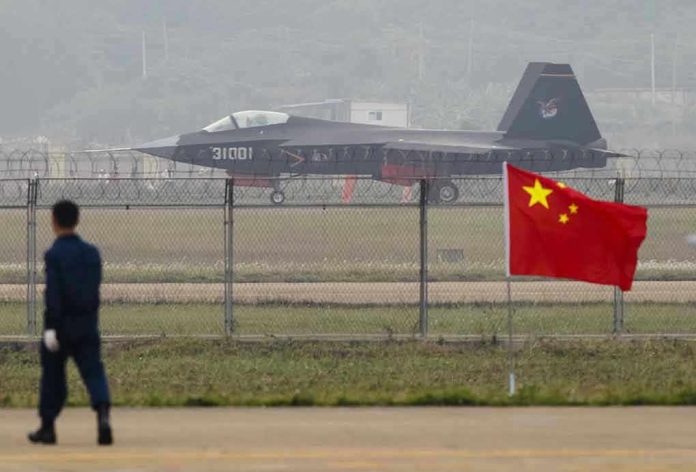
China’s construction of a nuclear-ready military city ten times the size of the Pentagon signals a direct challenge to U.S. security and global stability—raising urgent questions about America’s strategic preparedness.
Story Highlights
- China is building the world’s largest military command center near Beijing, designed for nuclear survivability and centralized control.
- The facility’s scale—ten times larger than the Pentagon—reflects China’s intent to rival or surpass U.S. military capabilities.
- Satellite imagery and intelligence confirm rapid construction, with over 100 cranes and extensive underground networks.
- The project intensifies U.S.-China tensions and could reshape the global balance of power.
China’s Military Expansion Signals a Strategic Threat
China has begun constructing a massive military command center, the so-called “Beijing Military City,” just 20–30 kilometers southwest of its capital. Spanning roughly 1,500 acres, this facility stands as the largest known military command center on the planet. Its design prioritizes nuclear survivability, featuring extensive underground bunkers and tunnel networks to protect the country’s leadership—including President Xi Jinping—and to ensure centralized command of the People’s Liberation Army (PLA) during a nuclear crisis. The scale of this project, ten times larger than the Pentagon, has alarmed American analysts who see it as a bold move to match or exceed U.S. military capabilities and disrupt the current balance of power.
Historical Context and China’s Push for Military Modernization
Since the early 2000s, China has rapidly modernized its military infrastructure, focusing on advanced command, control, and communication capabilities. This effort has gained momentum as the PLA approaches its centenary in 2027, marking a symbolic deadline for achieving world-class military power. The new command center replaces outdated Cold War-era facilities like Western Hills, reflecting a shift towards survivable, centralized control in nuclear scenarios. The strategic positioning near Beijing allows for rapid coordination and protection of the central leadership, underscoring China’s commitment to military modernization and deterrence against potential U.S. precision strikes.
Key Stakeholders and Power Shifts in Global Security
President Xi Jinping and the PLA are principal beneficiaries of the new command center, with the Chinese Communist Party driving the strategic decision-making. U.S. intelligence agencies are closely monitoring developments, recognizing the project’s potential to undermine American deterrence and operational advantages. The facility’s construction symbolizes China’s broader ambition to establish a resilient command infrastructure, centralize military control, and deter adversaries. This shift in power dynamics intensifies the U.S.-China rivalry and presents a significant challenge to traditional American security strategies in the Asia-Pacific region.
Current Developments: Intelligence, Construction, and Global Response
Satellite imagery from mid-2024 onward has revealed an accelerated pace of construction, with over 100 cranes and extensive underground excavation at the site. Despite official silence from Beijing, international media and defense analysts have publicized the project’s strategic importance. U.S. intelligence agencies continue to assess the implications, warning that the facility could enhance the survivability of Chinese leadership and military assets during nuclear or conventional conflict. The new command center has quickly become a focal point in global security discussions, with American policymakers scrutinizing its potential to shift military balances and embolden Chinese assertiveness.
Long-Term Implications: Strategic Stability and Constitutional Concerns
The emergence of China’s military city marks a transformative leap in global military infrastructure, raising questions about America’s readiness to respond to new threats. In the short term, the project has heightened tensions and prompted concerns about China’s command and control capabilities. Over the long term, it may accelerate arms race dynamics and force the U.S. to reevaluate its security posture. For conservatives, this development underscores the need to defend the Constitution, maintain robust military deterrence, and resist globalist agendas that weaken American sovereignty. The unchecked expansion of China’s military infrastructure reinforces the importance of vigilance and strong national leadership in preserving U.S. interests and values.
Expert analysts, including former CIA and NGA imagery specialists, confirm the facility’s scale and complexity, interpreting it as both a defensive measure and a sign of China’s aggressive ambitions. Multiple reputable sources, including The Wall Street Journal and Financial Times, corroborate the intelligence and satellite imagery, leaving little doubt about the facility’s existence and strategic purpose. China’s refusal to acknowledge the project’s details compels policymakers and citizens alike to rely on external analysis—and to prepare for the profound impact this military expansion may have on international relations and U.S. national security.
Sources:
Warning: New Command Center 10 Times Pentagon Size Exposes Massive Threat in Just 48 Hours
China Building New Military Command Center 10 Times the Size of the Pentagon







